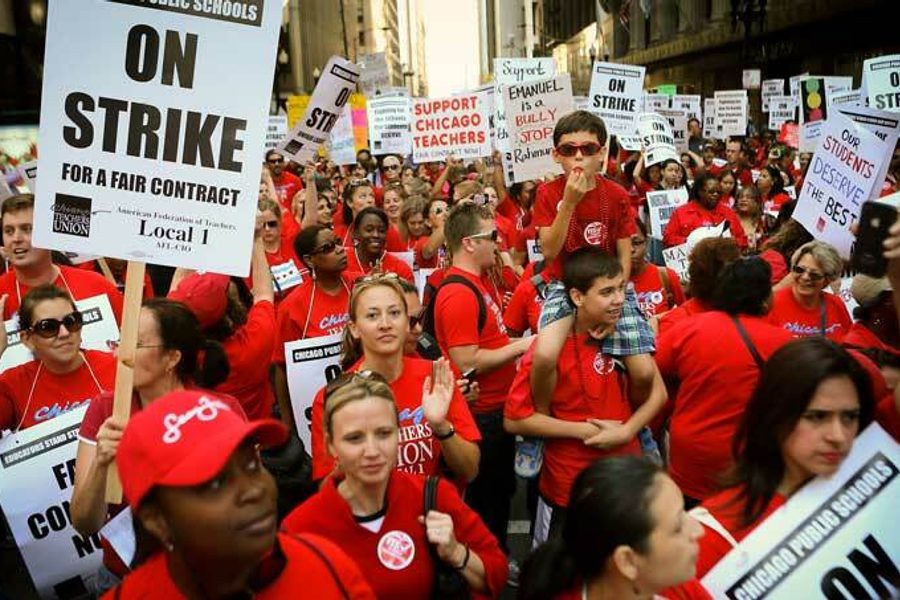The War on Teachers: Pick a Side
In Chicago, the teachers’ strike was hugely popular. In the national media, it was maligned.
Joel Bleifuss

In September, as picket lines of teachers in red T-shirts filled Chicago’s streets, the majority of Chicagoans were cheering on Karen Lewis, the president of the radically democratic Chicago Teachers Union (CTU).
Members of the national media, however, were wringing their hands, worried that children’s education was being imperiled by the entitled members of a public employee union.
These sentiments were found everywhere, from the pages of The Nation to the halls of the George W. Bush Institute. On no issue is elite opinion more united than on the need for education “reform” — at the expense of teachers and their collective bargaining rights.
A New York Times editorial damned CTU’s Lewis: “Her conduct during the strike has inflamed union members and raised expectations, making it difficult to bring them into line after the negotiating team finished its work.”
In The Nation, “Sister Citizen” columnist Melissa Harris-Perry bemoaned the “generation of children” who “are stuck … between the leaders and teachers who are supposed to have their best interests at heart but who seem willing to allow this generation to be lost.”
On NBC’s Today show, co-anchor Savannah Guthrie asked President Barack Obama about the strike. He replied, “I think Governor Romney and a number of folks try to politicize the issue and do a lot of teacher-bashing.” An incredulous Guthrie followed up: “Can you really say that teachers unions aren’t slowing the pace of reform?”
The so-called education reform movement is characterized by a fixation on school personnel management and a disregard for the fundamental economic inequalities that result in disparate educational outcomes. This personnel-focused approach is deeply appealing to upper-middle-class liberals, who often prefer technocratic solutions over social democratic programs that fatten the tax base.
The fact is, American public schools in affluent suburbs deliver high-quality education and have unionized teachers. And Northern Europe’s social democracies, which deliver the finest primary and secondary education in the world, boast formidable labor movements.
Of course, while the teachers unions are vilified by both wings of the political class, teachers remain very popular with parents and voters. Bruce Rauner, a hedge-fund billionaire and behind-the-scenes education advisor to Mayor Rahm Emanuel, understands this. As the teachers took to the picket lines, Rauner was speaking at the Art Institute of Chicago to a gathering of education experts convened under the auspices of the George W. Bush Institute. Said Rauner: “The critical issue is to separate the union from the teachers. … You’ve got to break apart the union bosses away from the really talented teachers.” In Rauner’s fantasy, Chicago’s teachers (who overwhelmingly voted in favor of the strike) can be pried away from the union over the issue of merit pay — this shows how much hedge-fund managers know about solidarity.
Democracy in action
On Sunday, September 16, the CTU negotiating team presented the union’s House of Delegates with the agreement it had reached with the school board. Instead of voting to end the strike as expected, the 800-plus delegates voted to take the proposal back to their schools.
The next morning, Lewis was a guest on WBEZ, Chicago’s NPR affiliate, where a skeptical talk show host asked her why she hadn’t instructed her members to end their strike. Lewis replied: “The union leadership does not tell the members what to do. … To me, having those discussions in the rank and file is so important. … We do take democracy seriously. And I know that’s frustrating for people, but in the end it is ultimately a better way to govern a union because it is not top-down leadership.”
After discussing the contract with their fellow teachers, the House of Delegates voted to end the strike. And on October 2, the members voted to approve the contract.
The CTU model of bottom-up, rank-and-file unionism is a refreshing alternative to the timid, bureaucratic labor movement we have known in this country for so many years.
In These Times Staff Writer Sady Doyle and I spoke with CTU President Karen Lewis. Here is some of what she had to say:
Bleifuss: Where does this idea that teachers are the root of the problem originate?
Lewis: The United States is almost back to the levels of income inequality and distribution that helped precipitate the Great Depression. So how do the people who are in charge continue to be in charge? One of the easiest ways is to start scapegoating the people who could actually perform the critical analysis of what is going on.
Then you have people making policies who don’t send their kids to public school, and who didn’t go themselves, and who have some sort of mythical vision in their brains about what inner-city schools are. I’m sick of other people thinking that they know what goes on in classrooms who have never been, as I like to say, on this side of the desk.
Why do people seem to have so much trouble with democracy?
Because nobody knows how to practice it anymore. Most organizations that are supposed to be democratic aren’t. There is always leadership control and people’s egos involved. But when people are part of the process, they feel a whole lot better about how things go. Certainly our union wasn’t democratic [before the 2010 election of Lewis’ reform caucus] and that was one of our goals, to change this into a democratic union that is responsive to its members. I trust our membership, totally. And when you trust your membership, good things happen.
What lesson could other union leaders learn from the CTU?
Every single union is different. Every local is different. The key is that people need to decide what they want their union to be, and I’m talking about members as opposed to leaders. Once members are happy with the way things are, then, okay.
Every union needs to do some soul searching about what its purpose is. If the purpose is to simply fight for wages and benefits, then the current models of unions work.
But the people I know believe that the union should be responsive to its members. And because we’re teaching in Chicago, we’re going to have to be responsive to our kids and their families, and to the situations in their lives. So we need to start working together to figure out how to solve some of our problems.
Why do hedge-fund billionaires want to demonize teachers? Why do they want to demonize the parents of the children? And why do they want to demonize and criminalize the children? This is what scares me.
Everyone is pointing blame in the absolutely wrong directions. That is why I’m so passionate about fighting corporate education reform. It is wrong.
Do you see teachers as the first line of defense?
Yes, against stupidity.
During the strike, many teachers were holding “Karen for Mayor” signs. Are you eyeing a run for office?
No! Absolutely not. How am I going to be a politician? I am bad at it. You’ve seen my YouTube videos.
I had my dream job, but what I saw was people who were trying to destroy that, and I felt like I had to stand up.
Joel Bleifuss, a former director of the Peace Studies Program at the University of Missouri-Columbia, is the editor & publisher of In These Times, where he has worked since October 1986.









